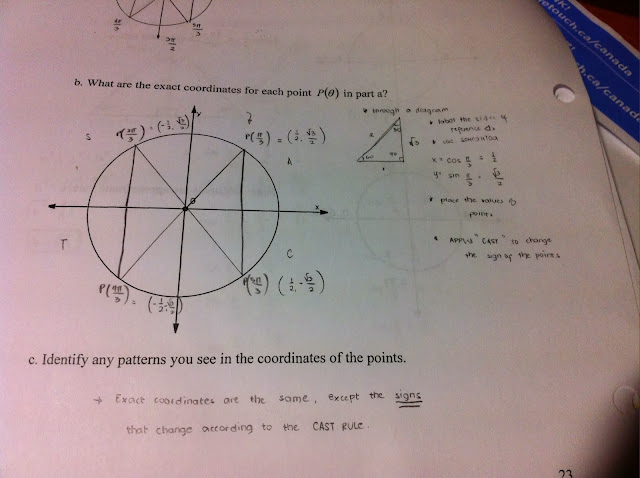Hello everybody, my name is Ariana. I am the middle of the 3 ladies who sit at the front table..........probably the one crying (I'm not fully on board and ready to steer this pre-cal ship, so please bear with me on this scribe as I write it while I dangle out, feet soaked in the cold ocean water). If you don't know me by now, feel free to introduce yourself!I I don't bite..... unless necessary :)
Now onto proving identities. Proving an identity is showing how one side of the equation, is the same as the other. (Left Hand Side = Right Hand Side). You can do so by separately simplifying both sides of the identity into identical expressions, Do not attempt to do both at the same time, this process is complicated and prone to much confusion. Also in some cases, you can get both sides identical with only one simplifying one equation. It doesn't matter which side you start with,your best bet is to start with the more complicated one.
As seen in our booklets here are some STRATEGIES (not to be confused with steps) that may help:
- Use known Identities to make substitution ex) tanx=sinx/cosx
- If qaudratics are present, the Pythagorean identity (sin^2theta + cos^2theta=1) or one of its alternate forms can be used. ex) sin^2theta/cos^2theta will become sin^2theta/1-sin^2theta
- Rewrite the expression using only sin and cosine
- Multiply the numerator and the denominator by the conjugate of an expression
- Factor to simplify the expression
Some examples we went over together in class:
Example a)
 |
| I apologize for poor quality pictures |
Starting with the left hand side (since we cant do anything to the right) the first step would be to change everything we can to sine or cosine.
Based on trig identities we know tantheta would become sintheta/costheta, csctheta would become 1/sintheta.
As we can see in the picture the cos and sin would cancel out, leaving us with only 1
Since 1 is what is on the right we have 1=1, LHS=RHS
Example b)
 |
| Quality plus my handwriting gets worse... |
On the LHS, first we change everything to become sine or cosine. Cottheta turns into costheta/sintheta and sec^2 becomes 1/cos^theta.
The costheta on the numerator would cancel with one on the denominator (remember that it's squared, we would still be left with one costheta).
Therefore our LHS is left with 1/sintheta costheta
1/ sintheta costheta is what is on the RHS, LHS=RHS
Example c)
In the LHS we convert tan to become sintheta/costheta.
The next step to this equation is to find the common denominator, which is costheta.
Apply the CD and we get sintheta costheta + sintheta/ cos theta.
Our next instinct might be that the costheta would cancel but that would be wrong because of that addition symbol.
The next step would be to factor out sintheta
Leaving us with LHS: sintheta(costheta+1/costheta)
For the RHS, of course we change to become sin or cosine.
1=sectheta/csctheta becomes *look on pic, for it does not look pretty typed*
Find the common denominator and then I'm pretty sure you already know the steps to simplify further.
The RHS is (costheta+1)sintheta/costheta
LHS=RHS
Example d)
In this special case we start by multiplying by the conjugate.
According to the Pythagorean identity we can change 1-cos^2 into sin^6.
Need I tell you what to do next?
LHS=RHS
 |







-page-001.JPG)

















